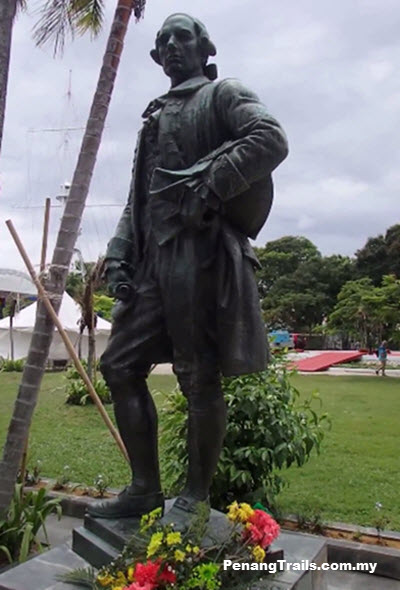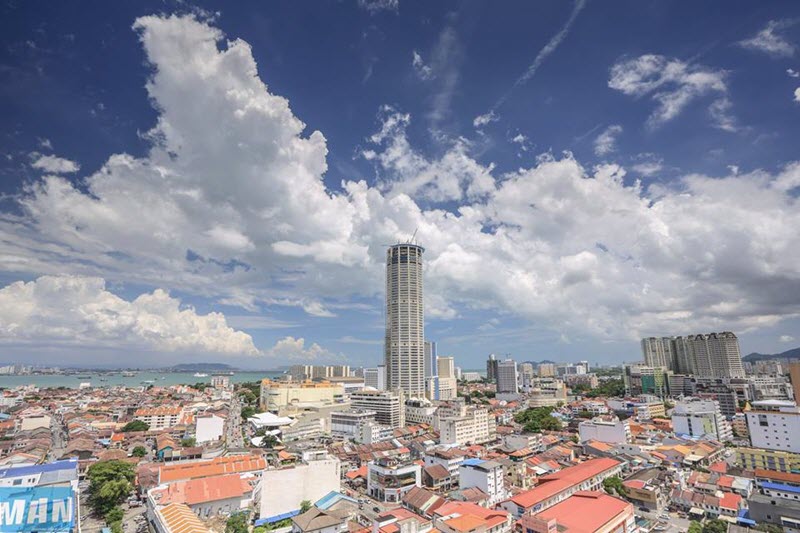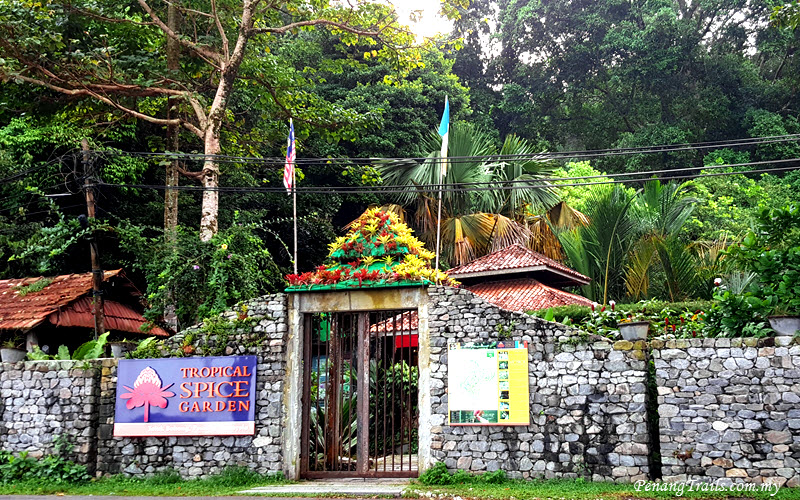Penang, the charms of her past, the sparkle of her present.
PenangTrails.com.my is a private initiative fully funded and supported by D’nonce Technology Berhad as part of its Corporate Social Responsibility program. PenangTrails.com.my is motivated not merely by our heartfelt passion to promote Penang to the rest of the world, we seek to present a comprehensive listing of all things about Penang and her people for locals and visitors alike to fully appreciate the history, quirkiness and potential of Penang.
PenangTrails.com.my provides an easy-to-follow and simple-to-operate digital approach to information. An approach of which we are confident will transform a simple search for facts into a pleasing voyage of discovery. We seek not merely to supply answers, but to provide background, colour and inspiration to turn a simple search into a stimulating and rewarding adventure. To equip you, and enable you, to sample Penang like a Penangite!
PenangTrails.com.my invites you to explore the beauty and depth of Penang through a rich selection of articles, photos, suggestions and a wide variety of recommendations to help make your visit to Penang memorable. We provide pointers on where to go and what to see and how to get there and what you can do when you arrive at your destination. We offer insights, opinions, and stories to help you understand and appreciate the people you will come across as you visit Penang.
The people of Penang are its life. Its soul. Its spirit. They are what makes Penang what it is today. We will introduce you to their lives, their work, their homes, their way of life and on our Gifted Penangites page, provide you with a showcase of the many talents of Penangites. We will explain and introduce the various cultures you will encounter as you wander through the friendly streets and markets here: Malay, Indonesian, Chinese, Indian, Eurasian, Acehnese, Burmese, Thai, Armenian … and the list goes on. Penang is an astonishing patchwork of co-existing cultures with their roots stretching back to the spice-trading world of centuries past.
Your interest may be on how the peoples of various cultures here live harmoniously together, how they worship, where they congregate, how they mingle, what their markets look like, their favourite beaches, the food they eat, how they shop, their talents. Or you may be an architectural buff, eager to view the important historical buildings, learn of their background, wander through historical buildings and places, take pictures, explore. You may have an urge to visit the hills, hike through the jungle, see butterflies and birds and plants and trees you have never seen before. PenangTrails.com.my caters to all these interests in a manner that informs, enlightens and entertains.
In our desire to promote Penang as a must-visit haven, a must-experience destination, we feature comprehensive lists of festivals and local events, tour experiences, and accommodation guide, list of heritage buildings, museums, places of worship, shopping malls, entertainment, sports & recreation centres, places to shop for local products, restaurants, locations offering Penang’s famous street food, health and amenity services. Should we have missed any feature that interests you, please tell us, and we shall add an article or two on it. We are here to serve. To help. To Inform. With feedback and your help, together we will succeed.

You Simply Must Visit Penang
“Penang, you have to go there!” … Why? …What is it about a place that makes it one you must visit? Why do we visit other places at all? Is it to broaden our understanding of the world by seeing how other cultures live and carry on their daily lives? Is it to get a feeling of what it might be like to live in a different environment, different climate, believe in different things, carry out different occupations from those we are used to? Or is it simply to enjoy the destination, to appreciate what is there in simple terms, like food and beach and sun and sand, a pace of life that is different from the one we are used to backing home? Whichever of these is your aim, Penang provides. First-class hotels or back-packer lodges, broad esplanades or quaint crooked streets, history, geography, jungles or birds – Penang really has got it all!

Penang Map
What, And Where, Is Penang?
Penang, in the local Malay Language, Pulau Pinang, (Pulau meaning island, Pinang meaning beetle nut), is the name given both to the island of Penang and the State. The State of Penang is officially known as Negeri Pulau Pinang. The State comprises both the island and part of the mainland it faces. Penang Island is off the northwest coast of peninsular Malaysia. It is 293 square kilometres in area, with the highest point of 788 metres. George Town, the original capital city, occupies the northwest tip of the island. Because of its history, the variety of traditional cultures that continue to exist there, and the significant concentration of culturally important buildings it contains, George Town, in 2008, was designated a UNESCO World Heritage Site.
What Makes Penang So Different?
The fascination with Penang is on account of the ethnic mix of its population, and the fact that in this day and age they assimilate and cohabitate as friends and worthy neighbours. This flavours the many different looks and habits, customs and dress, architecture and food that populate the island. But this situation did not arise overnight. It is the product of Penang’s long and colourful past. A past was driven by its attraction as a harbour, its proximity to several major trade routes, and its attraction both as a rest stop, and base for local trade. Penang today would not be what it is without its past.
Penang – The Historical Perspective
Archaeologists have indicated a Neolithic human presence in Penang dating as far back as five thousand years ago. The earliest recognised inhabitant groups (Semang-Pangan) were displaced by the Malays nine hundred years ago. Three hundred years later Penang Island was known, named, and already featured on the maps of the Chinese (the 1400s), Siamese (1500), English (1592), and Portuguese (1613).
In the early 18th century the Minang, from the highlands of West Sumatra, established a settlement on the Island. This was fully established by 1734. Arab traders followed and established their own settlement, in Jelutong, south of what is now George Town. The Arabs intermarried with the Minang and have since been assimilated into the Malay community. In 1786 Francis Light claimed the Island for the British East India Company, and Crown, regularised by a lease from the Sultan of Kedah. (The lease remains in place to this day, and continues to be paid by Penang, to the Sultan of Kedah.) The British connection remained in place until Malaysian independence in 1957.

Captain Francis Light Statue at Fort Cornwallis in George Town, Penang
During the colonial period, the population grew on Penang Island. Chinese were encouraged to immigrate to help develop the spice-growing economy, Indians became the principal workers for civic projects and government works. Trade in the early days of sail was with China, India, Siam, Dutch East Indies, Britain, Malacca and Singapore, bringing peoples from each of these countries to swell the growing population of Penang.
When Francis Light arrived the settlements of the Minang and Arabs, were already established, though both were small. A census that year suggested there were less than 100 inhabitants on the island. The next census, 25 years later, showed it to be 26,000. As pressure grew on the Penang administration to people the spice and trading economies, and develop civic projects such as road and water and sanitation, their solution was to attract and engage Chinese and Indian sources of labour. It is educational to imagine the population of those days. The Minang Malays and Arabs were already established, the Chinese were being welcomed with open arms, and the Indians had already established a foothold in civic works and were entering government service. Within 100 years, or four generations, the population had grown to 200,000.
Penang’s Current Population
The 2010 census figures give the Penang State population as 1.5 million, of whom 750,000 live on the Island. The ethnic breakdown of Penang Island’s Population is estimated (2010) as 41% Malay, 41% Chinese, 9% Indian, and the remaining 9% a fascinating polyglot mix of largely Western, Indonesian, Japanese, Korean, with smaller numbers from the Philippines, Bangladesh, and Nepal. A substantial number of these have been welcomed under Malaysia My Second Home scheme, a government initiative launched to attract overseas citizens to come to Malaysia to live and to enjoy the country’s many charms.
Penang, A Melting Pot Of Cultures

Pinang Peranakan Mansion at Church Street
230 years, or ten generations, have passed since the population of Penang Island stood at 100. After so many generations of developing together, and living side by side, the different races have blended closer to each other. One such group is the Peranakan, or Baba-Nonya. These are the descendants of the early Chinese Immigrants who married locals. They have distinctive tastes, and dress, and architecture, the roots of which are not from China, but Malaysia, particularly the Straits Settlements of Singapore, Malacca and Penang. They have borrowed heavily from the local availability of spices, and influences of other ethnic groups, to produce their very own style of cooking: Nonya Cuisine. Some of the Indian groups, too, have drawn closer to their neighbours with many adopting manners and beliefs more akin to Malaysia than those followed in the homes of their Indian ancestors.
Penang As The Early Leader In Banking, Commerce And Trade
Commercial building and banking in Beach Street, Penang
Penang was a commercial and banking centre when Kuala Lumpur, the capital of Malaysia today, was still a small outpost. Standard Chartered opened its first Bank in Beach Street, the old commercial centre of George Town, in 1875. Hong Kong and Shanghai Bank followed soon after. As did ABN AMRO, in 1888. A walk down Beach street today, with its remaining sturdy bank-style buildings, can take one back in time. The austere, mostly granite, bank buildings make it easy to imagine what it was like all these years ago.
Logan Heritage
Buildings, especially those over which care has been lavished, and attention to detail applied, are often reflective of their function. Penang’s are no exception. There are bank buildings in Beach Street, Law Courts nearby, Government Administrative Buildings. There are Mosques, Temples, Churches, Shop Houses, terraced houses, high rise modern buildings, even some palatial dwellings remain to this day, to the north of the E&O Hotel. There is a fishing village by the Jetty; some wonderful old wooden kampung houses can still be seen in Balik Pulau. If you are an aficionado of architecture, or keen on places of worship, or interested in traditional house styles, or have a particular affection for grand facades, then do a little homework, arm yourself with a map, and take to the streets. You won’t be disappointed.
“Boy on a bike” street art mural by Ernest Zacharevic
Adding to the attraction of the old parts of George Town, especially around Armenian Street, was the decision reached by the organisers of the George Town Festival of Art and Culture, in 2012, to have Lithuanian Artist Ernest Zacharevic create a series of 6 wall paintings. ‘Children on a bicycle,’ remain one of the most popular. It is frequently emblazoned on T-shirts. Since that start, other artistic features have appeared in the streets, and are still appearing: some murals, some wrought Iron caricatures just waiting to be discovered … as is the food.
Penang Food Is Truly A Feast For The Senses

New Lane Food stall
The Lonely Planet Guide in 2014 described Penang as one of the World’s top food destinations. Its main claim to food fame is street food. Hawker food. Foods that you eat outdoors, in the open, in the company of others, on plastic stools, round tables that are not always steady. Food that has its roots in cooking which was once Chinese, or Malay, or Paranakan, or Indian, or Thai – or a mixture of two, or more. It is aromas of ginger, turmeric, garlic; onion and lemongrass; fennel and clove and chilli. It is chapatti and roti, rice and omelettes, flat noodles, thin noodles, string noodles, rice noodles, yellow noodles, noodles in soup, or dry, or fried. It is fresh fish, live fish, steamed fish, fried fish, squid, and crabs, and cockles and oysters and prawns. It is food to be explored, sampled, tested and enjoyed. The secret to enjoying it is simple: a willingness to try, and a readiness to ask. As Time Magazine wrote, when adjudging Penang, ‘the location for the best street food in Asia’: “Nowhere else can such great tasting food be so cheap”.
And then there are the Festivals

Penang Hot Air Balloon Festival Fireworks Display
Just as the traditions of culture and beliefs influence dress and manners and food and architecture, so too do they draw in their wake special days and a host of colourful festivals. Penang has so many, a calendar is needed just to keep track of them all. (What follows is only a selection!) January is the Hindu Thaipusam; February, Chinese New Year and Chap Goh Mei; March, St Patrick’s Day; April, the Buddhist Songkran; May, the Sikh Vaisakhi Celebrations; June, Buddhist Wesak Day; July, this year, the Muslim Hari Raya Aidilfitri, the Christian St Anne’s Festival, the Japanese Bon Odori Festivals; August, the Festival of the Hungry Ghost; September, Chinese Mid Autumn Festival; October, the Hindu Navratri and Deepavali; November, the Pesta Pulau Pinang; and December, Christmas and New Year countdown. Unarguably something for everyone!
But there is more: Fashion Week in April, Dragon Boat Festival in May, a Japanese Anime Festival in June, the Durian Festival, and the Penang Floral Festival at the Botanic Gardens in July, coinciding with the start of the annual George Town Arts Festival. And it doesn’t end there! If you feel like a run, the Penang Bridge Marathon is held in November. You can choose from the full 42K, or the half marathon, or 10K, or the fun run. Some classical music, or Jazz? Penang has its own symphony orchestra, and in December the Penang Island Jazz Festival is held in Batu Ferringhi.
Whether the Weather?
When is best to visit? The two hottest months in Penang are February and March. The coolest are September and October but they are also the wettest. December, January, June and July, offer perhaps the ideal combination of not too hot and not too wet. But it is the tropics, after all. Where it is hot, and rains. So for the other months … simply bring sun cream, and an umbrella. One thing is for sure, you will not be cold.

Places To Stay?

Parkroyal Penang Resort
Accommodation is available at every budget level. From 5 star international hotels to backpacker lodges and homestays. Four areas are containing most of Penang’s public accommodations. The first is around the Free Trade Zone and the Airport and caters principally to those visiting Penang for work. The second, George Town, is for those with an interest in food and tradition, as the greatest concentration of restaurants, and historical buildings, are to be found there. Batu Ferringhi is the tourist strip, with the beach and swimming pools and vast tracts of hotel grounds given over to lazing and reading and sunbathing and generally … being pampered! It is also where the tourist hawker markets open every night. Lastly is Tanjung Bunga, which has its beach, and pools, and views of the sea, but also a growing array of restaurants close by. Tanjung Bunga is halfway between George Town and Batu Ferringhi, so has some of the advantages of each.
Getting Out And About, Communing With Nature, Going Into The Hills
George Town view from Penang Hill
For those who enjoy a bracing walk in interesting terrain, Penang is a goldmine. Most of the Batu Ferringhi hotels offer Nature Walks as part of their entertainment program. This may be near the hotel, or a short ride away in the National Park at Telok Bahang. The Park has well-marked trails. One winds along the coast to Monkey Beach and the Muka Head lighthouse. One climbs over the hill to Pantai Kerachut, where turtles visit to lay their eggs. One is a demanding ridge hike that takes in Bukit Batu Itam, the highest hill in the park, at 464 metres. Guides are available, as are boats to pick you up should you prefer only to hike one way.

Botanic Gardens
There are numerous trails in and around and leading away from the Botanic Gardens. In the vicinity a large hiking community can be found, setting off at all hours of the morning and early afternoon, dressed in psychedelic walk gear, equipped with high-tech sticks, and the very latest in modern packs. And then there is Penang Hill itself, overlooking all. Several long-distance trails will take you to the summit from a variety of locations dotted around the island. For many, the preference is to catch the funicular railway to the top of the hill, then take a walk on the summit itself.

This year sees the opening of the Habitat Trail, and perhaps too, the Penang Hill Nature Trail. The first is a well-manicured broad walkway around the contour to the north of the hilltop. It features botanical displays and explanatory information at points along the way. There is also a canopy walk and soon, it is hoped a zip line. The second is a longer path that meanders south and east around the summit. Parts of this trail follow the route of the 150-year-old Moniot Trail, named after an early surveyor. The Nature Trail is a path through the primary jungle. It has not merely nature, and birds and butterflies in the raw, but also some stunning views along the way.

Much of the research and field studies carried out by Darwin’s co-evolutionist, Alfred Russel Wallace, was done in peninsular Malaysia. Much of what he studied is present in Penang today: two types of monkeys, giant squirrels, flying lemurs, pygmy deer, exotic birds, and a truly mesmerizing array of butterflies. All can be found and enjoyed – if you’re careful, observant, and quiet – on the trails.
Two Pearls Worth Visiting

Tropical Spice Garden
With so much to see, and do, and experience in Penang, it is difficult to select any favourite. Everyone’s taste is different. But two particular favourites of ours should be mentioned, if for no other reason than they are outstanding examples of their art, even judged by international standards. The first is the Butterfly Farm at Telok Bahang, recently entirely refurbished. The second, the Tropical Spice Garden, on the way from Batu Ferringhi to Telok Bahang has also been recently upgraded. Both care about what they are hosting – butterflies in one case, tropical spices and plants in the other – and both know how to present their subject well. The result in each case is outstanding and rewarding, venues to visit.
End piece
We hope this has provided a quick impression of the Penang we love. Impressions that will help you when you move further into the site to gather more details and locate what you ideally seek. It is easy for us, as we are huge fans of Penang. We hope with the help of this site, you will become one too.
